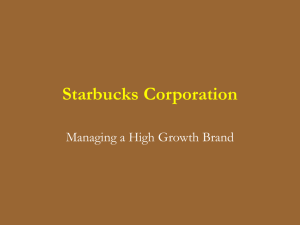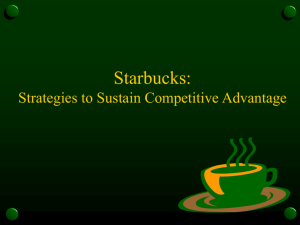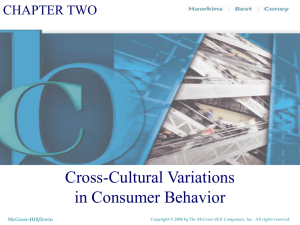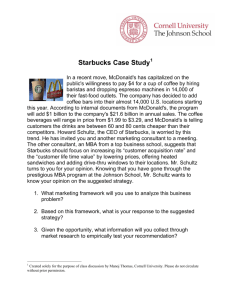Average American Worker Spends Nearly $1100/Year On Coffee
advertisement
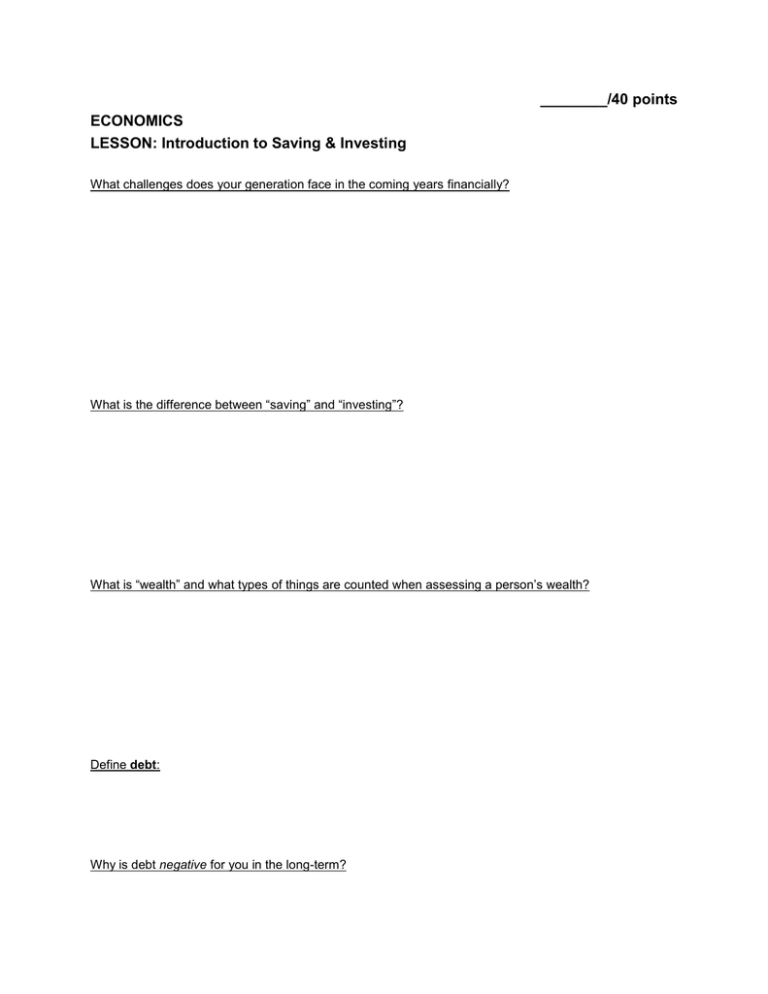
________/40 points ECONOMICS LESSON: Introduction to Saving & Investing What challenges does your generation face in the coming years financially? What is the difference between “saving” and “investing”? What is “wealth” and what types of things are counted when assessing a person’s wealth? Define debt: Why is debt negative for you in the long-term? In what ways can debt be actually “good” for you in the short-term (providing you can pay it back)? Compare “good” debt against “bad” debt. What’s the difference? Explain things you think might cause you debt in your own life. Is this “good” debt? Or is it “bad”? Describe ways you can prevent debt from overtaking your financial life: Wed, Jun 3, 2015, 8:08 AM EDT What Your Starbucks Habit Really Costs You It's getting a little more expensive to have a Starbucks habit. The Seattle-based coffee company (SBUX) said Tuesday that it would hike prices by an average of 1% in the Northeast and Sunbelt regions, where prices haven't been raised in roughly five years. Starbucks is following the lead of other food companies, including McDonald's and Chipotle, which have hiked prices in the past year to cope with rising commodity costs. The company said the average price of a "tall" -- the smallest drink -- brewed beverage will rise by 10 cents in New York. This morning the price hike was already in effect, as caffeine cravers shelled out $2.01 for a cup of coffee, up from $1.91. The coffee house allows for some regional pricing, so the actual cost of your morning habit could vary. But that could easily bump the price of a large -- "venti" -- latte over $4 a cup, not including tip. If one of your resolutions is to cut costs this year, it might be worth noting what your coffee habit is going to cost you over time. If you buy one $4 latte each day, that coffee habit will set you back $28 a week, about $120 a month and $1,460 per year. Keep that up for five years, and you've slurped away $7,300, not including any money you might have earned by investing your cash instead. If you account for missed investment returns, the loss amounts to roughly $9,300 (assuming a 9% average return). After 10 years, your Starbucks habit costs you a car. After 30 years, the $239,891 that you drank away (including investment returns), could have bought a house. Over 40 years, the Starbucks habit could reduce your retirement nest-egg by an astounding $634,428 -- enough to generate an income of more than $2,600 a month. No one is suggesting that you give up your daily jolt of joe. (This would be a particularly unlikely suggestion from me -- the person whose caffeine addiction built that impressive tower of latte cups.) But you might want to consider a cheaper way to go at it. Costco, for example, sells a 2.5 pound bag of Starbucks French roast for $22; A couple gallons of milk will run another $7. For that $29 -- roughly the cost of a week of barista-made lattes -- you can have a pot of lattes every day for at least a month. Net savings: $91. Invest that in a diversified basket of stocks and you could have your jolt and your retirement plan too. Based on these numbers -- and investment returns of 9% annually (about the historic average) -- the amount you save by brewing your own Starbucks coffee could be worth $481,108 at retirement 40 years from now. Average American Worker Spends Nearly $1,100/Year On Coffee By Chris Morran January 20, 2012 Some say that coffee is the fuel that keeps the American workforce moving forward. And it’s a fuel that comes with a hefty price tag, as a new study shows that the average member of the American workforce spends almost as much on coffee every year as they do on commuting to and from their job. According to Accounting Principals’ latest Workonomix survey, the average American worker is shelling out more than $20 a week on coffee, for a yearly average of $1,092. Whereas commuting costs for the average worker come out to around $1,476 per year. And when you consider the volume of your typical coffee drink versus a gallon of gasoline, it looks like we place a higher value on our java jolt than we do on the 87 octane in our gas tanks. The younger whippersnappers (ages 18-34) in the office are paying almost about $10 more per week on coffee than their 45-and-older counterparts ($24.74 vs. $14.15, respectively). Another huge expense for the American worker is lunch, with 66% of the workforce opting to buy their midday meal rather than pack one. This comes at an average cost of around $37/week, making it significantly more expensive than commuting or coffee. However, with times still being tough, 35% of the survey respondents told Accounting Principals that they have made it a goal to start packing lunch this year to save money. And, perhaps not surprisingly, that 18-34 age group is paying a lot more for lunch than the 45+ set ($44.78 vs. $31.80, respectively). Worth mentioning here is that, when asked what they thought their biggest work week expense was in the last year, 42% of respondents thought it would be commuting costs, and only 11% chose lunch expenses. ASSIGNMENT: Analysis of Everyday Spending 1. Explain what point each article is making about individual spending. Why do you think the authors used coffee as the example? What other items could you imagine being used as examples (describe three and why). 2. Think about the things that you spend money on and what they mean to you. Now imagine you want to buy something this summer or in the fall. Describe specific steps you could take toward this goal using small, everyday adjustments in your spending. Please provide an example for this. 3. Think about your family’s spending and budget needs. What do you think takes up most of your family’s spending and money? In what way do you think your family (or household) could improve upon its spending and what do you think it does well now? 4. Respond to “Activity 2” (from PowerPoint), both with the three stages and your summary response.



